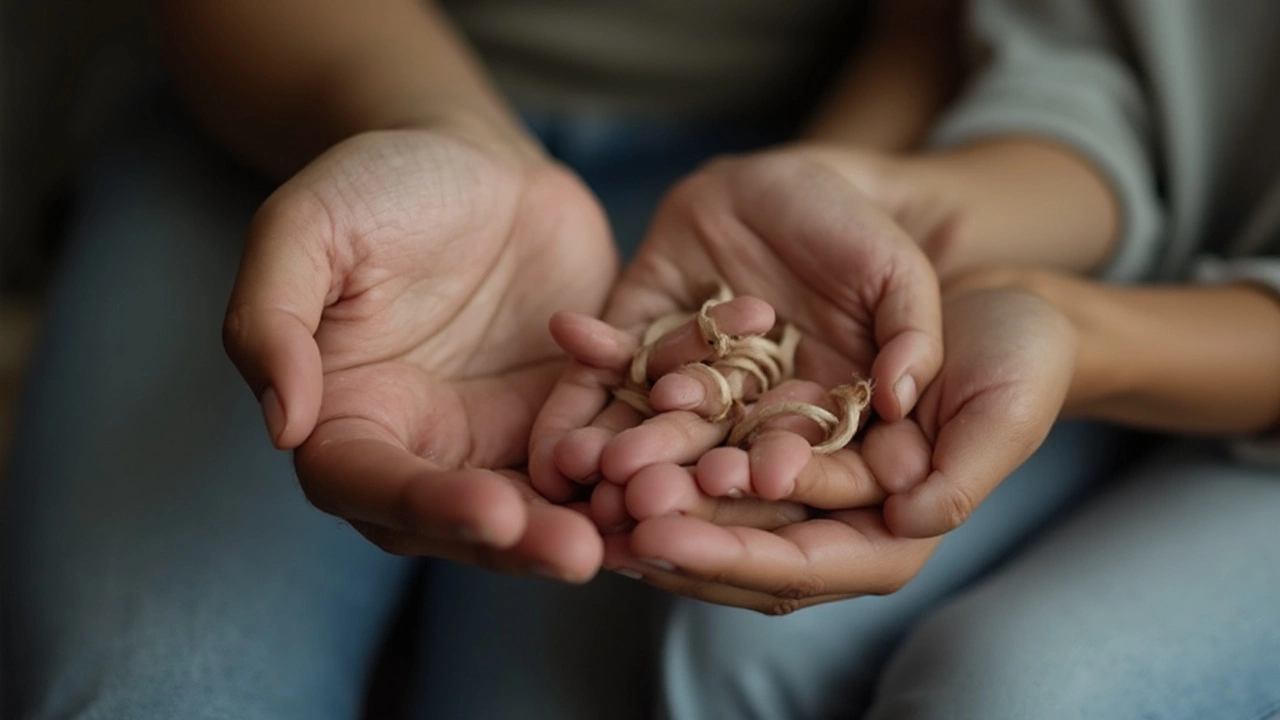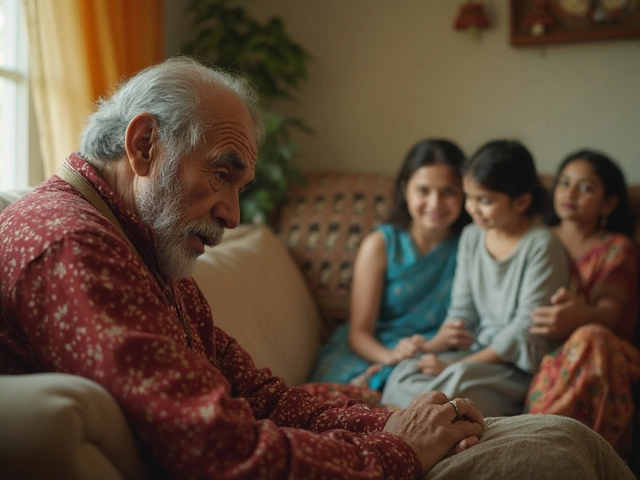
Has your therapist ever locked eyes with your hands instead of your face? It's not because they're distracted—it's because your hands often blurt out what your mouth tries to hide. When you fidget, clench your fists, or tuck your hands under your thighs, you’re sending out emotional smoke signals whether you realise it or not.
In therapy, many people struggle to put their feelings into words, sometimes without even knowing what those feelings truly are. That’s where hands come in. A quick twitch, tapping your fingers, or twisting a ring can give away nerves, stress, anger, or even excitement. Therapists are trained to notice these subtle hand cues so they can catch the stuff you might not be ready—or even able—to say out loud.
If you’re ever wondering, “Why does my therapist care if I’m picking at my nails?” it’s because these little habits are a sort of emotional Morse code. Your hands pretty much spill your secrets before your voice does. They reveal discomfort, defensiveness, openness, or tension in the moment, and your therapist is trying to read all parts of your story—spoken and unspoken.
- Why Therapists Notice Your Hands
- What Your Hand Movements Reveal
- How Therapists Use Body Language Clues
- Using Hand Awareness to Improve Therapy
Why Therapists Notice Your Hands
Most people focus on what they’re saying in therapy, but therapists keep an eye on your body language, especially your hands. Your hands can give away what’s really going on even before you start talking. Research shows that over 60% of our communication is actually nonverbal, including hand gestures and fiddling with objects. That’s why therapists don’t just listen; they watch.
Here’s the deal—our brains react fast when we’re uncomfortable, anxious, or hiding something. Sometimes our hands start picking at cuticles or squeezing the edge of the couch before we can process our own stress. Therapists rely on these cues to notice feelings or worries that might not come up in conversation just yet.
"Hands can leak information our words don’t—sometimes our stories are broadcast clearly just by how we hold ourselves," says Dr. Paul Ekman, psychologist and pioneer in emotion research.
Therapists are trained to spot these moves and link them to your mood or stress level. For example, clenched fists can hint at anger or defense, while open palms usually mean trust or comfort. Even small things—like rubbing hands or hiding them in your pockets—are clues worth tracking.
- Hand-wringing often signals anxiety.
- Crossed arms with tightly held hands can show defensiveness.
- Tapping your fingers might reveal impatience or nervous energy.
Check out these quick facts on body language observed in therapy:
| Hand Movement | Possible Meaning | Frequency Noticed by Therapists (%) |
|---|---|---|
| Fidgeting | Stress/Anxiety | 75 |
| Clenched Fists | Anger/Defensiveness | 62 |
| Hiding Hands | Shame/Avoidance | 57 |
Therapists put all these pieces together to better understand what’s really going on with you. They don’t just hear your story—they see the whole picture, hands and all.
What Your Hand Movements Reveal
Your hands are like a real-time emotional map. Even if you try to play it cool in therapy, your gestures, fidgets, and hand habits are sending out nonstop messages. For therapists, these tiny movements help fill in the blanks between what you say and what you actually feel. Sometimes your hands are more honest than your words.
Ever cross your arms tight or tuck your hands away when things get heavy? That can look like defensiveness or wanting to put up a shield. Open palms resting on your knees? That usually means you’re open to talking and maybe ready to trust a bit more. Therapists watch for these patterns because they tell the story your words might miss.
Fidgeting—with rings, buttons, or even pulling sleeves over your hands—is common when you’re anxious or uncomfortable. Balled-up fists can mean anger, stress, or just trying to hold it together. Research from psychologists at the University of California found that people often fidget more when talking about topics that make them feel exposed or stressed out. These small signs help therapists spot what’s really bothering you even when you’re not speaking up.
- Picking at your fingernails or skin may mean you’re nervous or feeling judged.
- Tapping your fingers shows impatience or that you’re holding back.
- Clenched fists might point to anger or hidden frustration.
- Smoothing clothing or hair can be a way to comfort yourself when you’re anxious.
Therapists aren’t spies, but they notice these hand movements for good reason. Sometimes, if you and your therapist talk about why your hands do what they do, it can unlock bigger conversations about stress or old habits linked to deeper stuff. If you’re curious, ask your therapist what they notice. You might learn something big about yourself—your therapist will definitely have some thoughts!

How Therapists Use Body Language Clues
Therapists pay close attention to the small stuff—the shuffle of your hands, how you tap a foot, or the way your arms cross. Why? Because these actions usually show how you’re feeling before you even say a word. In mental health sessions, therapists are trained to tune in to these signals. Research shows that over 60% of emotional communication happens through body language, not words. So if your hands are clenching, you’re probably dealing with anxiety or holding something back, even if you’re saying, “I’m fine.”
Here’s what therapists often do with these body language cues:
- Check for contrast: If your story says one thing, but your body screams another, your therapist knows to dig a little deeper.
- Spot patterns: Always hiding your hands or picking at your skin when a certain topic comes up? That’s a clue about what’s really getting to you.
- Gauge comfort: Relaxed, open hands may mean you’re comfortable or honest right now. But if you’re clenching or hiding them, you might be on edge or guarded.
- Prompt conversation: If your therapist catches a sudden change—like you go from open gestures to closed fists—they might pause and gently ask what’s on your mind in that exact moment.
In fact, a 2023 survey by the American Psychological Association found that therapists who actively track body language (including hand gestures) report better client understanding and stronger trust with their clients compared to those who just listen to words. Check out this quick data roundup:
| Communication Method | Emotional Info Conveyed |
|---|---|
| Words | 30%-35% |
| Body Language (hands, face, posture) | 60%-65% |
| Tone of Voice | 5%-10% |
This table breaks down just how much body language holds weight in understanding what's really going on. Therapists lean on this info so they can support you better, ask the right questions, and help you dig into things you might not even realize you’re feeling.
Using Hand Awareness to Improve Therapy
If you know what your hands are doing while you talk, you can actually help your therapy go deeper. Noticing how you move, grip, or hide your hands can put you in touch with feelings you might not notice otherwise. Even researchers at the American Psychological Association have found that nonverbal cues like hand gestures are key in understanding a person’s real emotional state.
“Our bodies express things our mouths cannot. If you pay attention to the small ways your hands react, you might catch your own stress, excitement, or anxiety long before you find the words for them.” – Dr. Catherine Steiner-Adair, clinical psychologist
So, how do you use this in your own sessions? It doesn’t have to be complicated. Try these quick tips:
- If you catch yourself making the same hand gesture (like picking at your nails or balling a fist), pause and ask yourself what you’re feeling right then.
- Share what you’re noticing with your therapist. Something simple like, “I just realized I keep twisting my ring when we talk about my job,” opens up a bigger conversation.
- Experiment outside sessions, too. When you’re nervous or triggered in daily situations, look at your hands—are they tense, sweaty, hiding? That’s real-time emotional feedback.
- Jot down daily notes on your hand habits paired with what you felt in that moment. This can give you and your therapist actual data to work with.
To spell it out, getting curious about your own hand movements turns you from passive passenger to someone who’s helping steer the session. It makes the whole therapy process more honest and focused.
| Hand Behavior | Possible Feeling | How to Respond |
|---|---|---|
| Clenched Fists | Anger, fear, resistance | Breathe and try to open your hands; tell your therapist. |
| Hiding Hands | Shame, insecurity | Ask yourself what feels risky right now. |
| Tapping Fingers | Impatience, anxiety | Pause and notice your body. |
| Resting Hands Open | Comfort, openness | Tell your therapist if you notice this shift. |
When you pay attention to hand signals in therapy session, it gets easier to catch feelings as they pop up—not just after the fact. You’re basically building another way for your brain and emotions to talk to each other, which makes your therapy sessions way more useful.








